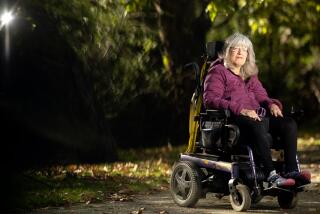Ruling Limits Damages for Asbestos Firms
- Share via
SAN FRANCISCO — Asbestos victims and others injured by exposure to toxics can collect only limited damages in court if their illnesses were undetected when voters passed the 1986 so-called “deep pockets” initiative, the California Supreme Court ruled Monday.
The 6-1 ruling stemmed from a lawsuit brought by Northern California asbestos victim James Buttram, who did not discover his cancer until 1991, at least seven years after evidence showed that the fatal disease began developing in his body.
The Supreme Court said the industry-backed “deep pockets” measure, which apportioned pain and suffering damages according to a defendant’s degree of fault, applies to all litigants whose illnesses remained unknown at the time of the initiative’s passage.
As many as 20,000 asbestos litigants in the state could be affected by the ruling, lawyers in the case said, and the decision may reduce significantly the amount that asbestos victims and others exposed to toxic substances can collect from manufacturers and other defendants. The ruling may even limit damages for such injuries as repetitive stress, caused by repeated use of equipment, according to one defense lawyer.
Before the passage of Proposition 51 in 1986, a single well-heeled defendant, or “deep pocket,” could be forced to pay all pain and suffering damages if other defendants were insolvent or could not be found. Pain and suffering damages are awarded for both physical and mental pain. They often account for half or more of jury awards in asbestos cases.
Justice Marvin Baxter, writing for the majority, said there is no pain and suffering until an illness has been discovered. By applying the “deep pocket” measure to all injuries detected after its passage, the court is furthering “the purposes of the tort reform measures,” Baxter wrote.
*
But Justice Stanley Mosk, in a dissent, complained that the ruling will deprive victims of full compensation. In deciding whether to apply Proposition 51, which was not retroactive, the date of the injury should be the time when physiological changes leading to the disease begin, Mosk wrote.
Buttram died in 1995 at age 52. He was exposed to asbestos while serving in the Navy during the Vietnam War.
In 1991, a routine chest X-ray revealed that Buttram had lung problems and further tests showed that he had pleural mesothelioma, cancer of the lining of the lung caused by asbestos exposure.
Buttram sued Owens-Corning Fiberglas Corp., a maker of asbestos, and other firms that he blamed for his illness. An Alameda County jury eventually awarded Buttram $1.5 million, including $450,000 for pain and suffering. The trial court and the Court of Appeal ruled that Owens-Corning should pay all of the pain and suffering award because Buttram’s illness had begun before passage of the “deep pockets” initiative.
By overturning those decisions, the California Supreme Court has made the asbestos maker responsible only for 28% of the pain-and-suffering damages, the proportion that the jury found was Owens-Corning’s fault. Other defendants settled for various amounts before the trial, and those amounts were to be deducted from the final damages against Owens-Corning.
Dianna Lyons, an attorney for Buttram, contended that Monday’s ruling now assures large companies that they will be partially let off the hook when their actions cause damage decades later.
“If you manufacture a slow-acting poison and sell it to people or give it to people . . . you just lobby like hell to get the law changed and you are no longer responsible,” the Oakland attorney said.
*
But Thomas H. Nienow, who represented Owens-Corning, praised the state high court for producing a “workable” result that he said was consistent with other laws. He predicted that future asbestos defendants will be less likely to settle claims out of court or will now settle for less because they know they cannot be hit with the full pain-and-suffering award.
“Certainly they will be less likely to pay a lot of money,” Nienow said.
Larry L. Simms, the attorney who represented Owens-Corning before the state high court, said the firm was “very pleased” with the decision because it has been “hit for all the other misdeeds” of much larger but now bankrupt asbestos makers. The ruling will affect toxic chemical cases in which injuries do not appear for decades after exposure, Simms said.
Buttram died while the manufacturer was appealing the verdict and the remaining damages will now go to his estate.
More to Read
Inside the business of entertainment
The Wide Shot brings you news, analysis and insights on everything from streaming wars to production — and what it all means for the future.
You may occasionally receive promotional content from the Los Angeles Times.











